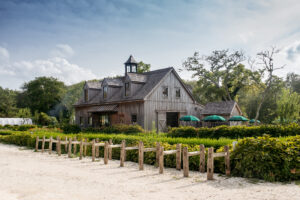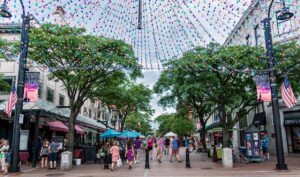ONE OF MY FONDEST memories of summers cruising along the Garden State shore actually happened about an hour inland. We were on Route 70, an ages-old highway connecting Philadelphia to the state’s seaside communities, where six lanes dwindled to two past the town of Medford. There we would stop at one of the two, back-to-back farmer’s markets, Red Top and Green Top.

Our family would load up on Jersey beefsteak tomatoes, button-sized blue-hued berries, fragrant juicy peaches, husk-on corn still wet with morning dew and a big purple eggplant or two. These fresh fixings made meals on board memorable during a long weekend voyage from Barnegat Bay, south to Great Bay and finally Cape May.
New Jersey, a small peanut-shaped mid-Atlantic state bordered by New York, Pennsylvania, Delaware and the Atlantic Ocean, ranks No. 1 as the most densely populated state in the nation. Yet, the Garden State does live up to its nickname. New Jersey also ranks No. 1 in the United States in eggplant production, and in the top 10 nationwide for its harvest of tomatoes, blueberries, peaches, peppers, squash, cucumbers and asparagus.
This bounty grows on nearly three-quarter of a million acres and on nearly 10,000 family-run farms, much of these located in the central and southern part of the state, and many are multi-generations old. In fact, 18th century founding father Benjamin Franklin once referred to New Jersey as “a barrel tapped at both ends” supplying fresh produce and other products to New York at one end and Philadelphia at the other.
“New Jersey farmers grow more than 100 different types of fruits and vegetables,” says Douglas Fisher, Secretary of the New Jersey Department of Agriculture, which administers the Jersey Fresh marketing program. “Tomatoes are among the crops that state is most known. New Jersey tomatoes have been developed and perfected by Rutgers University for more than a century. The reputation for the sweet taste was enhanced when Campbell’s Soup in Camden began using Jersey tomatoes in 1915.”

Fisher’s 100 kinds of produce count mainstream items as well as an ever-increasing niche of Latin, Asian and African favorites such as bok choy, jalapeno chilies and Malabar spinach, which cater to the state’s multicultural population’s tastes. Overall, warm days, cool nights, a combination of rich loam and well-drained sandy soil, and abundant rainfall contribute to New Jersey’s reputation for great-tasting produce.
One of the best places to buy Garden State fruits and vegetables is at local farmers markets. Closer than an hour’s drive up Route 70, many operate from Memorial Day to Labor Day along Jersey Shore towns such as Surf City, Brigantine and Ventnor, and most markets are close to marinas.
“We offer New Jersey grown tomatoes, both traditional and heirloom, corn, zucchini and zucchini flowers, eggplant, kale, herbs, beautiful flowers, and more from the two nearby farms we source from,” says Natalie Caricato, organizer of the Surf City Farmers Market, located on Long Beach Boulevard.
In addition to fresh produce, the Brigantine Farmers Market, located on Revere Boulevard, hosts a demo tent. “We invite a local chef who shops the market with $35, and then uses these ingredients to make a meal. Market patrons can sample the dishes, take photos of the recipe and shop for the same ingredients to make the dishes themselves at home,” says Christell Lauletta, the market’s vendor relations and operations manager.
Last summer, one of these chefs was Nicole Gaffney, a finalist on the reality show Food Network Star, who owns Soulberri Coffee & Smoothies on the island.
Farmer’s market shoppers can get in on competitions, too. The Brigantine Market contests include Blueberry Baked Items, Fresh Tomato Sauce versus Gravy Wars, and the New Jersey Peach Council Pie Contest, all open to non-professional chefs and home cooks. The Ventnor Farmer’s Market runs salsa-making contests with featured ingredients such as Jersey tomatoes. It’s located at the corner of Atlantic and Newport Avenues in Ventnor City, a short three-block walk from the Newport Marina.

Thirty nautical miles south of Ventnor is Cape May, and none of our summer cruises was complete without a stop in this Victorian-styled town. While there is not a farmers market along the oceanfront on Beach Avenue, the Blue Pig Tavern at the 19th century Congress Hall Hotel serves dishes with ingredients harvested at its 62-acre Beach Plum Farm in West Cape May.
Signature in the summer is a Jersey Tomato Sandwich Menu, where guests can choose from a variety of breads and toppings. This is a doubly good way to sample Jersey fresh, just-picked fixings with professional preparation. Having access to Jersey restaurants such as the Blue Pig and farmers markets such as Surf City, Brigantine, Ventnor and other seaside towns, means that you don’t need to stock up on Garden State produce far inland before arriving at your boat on the shore.





